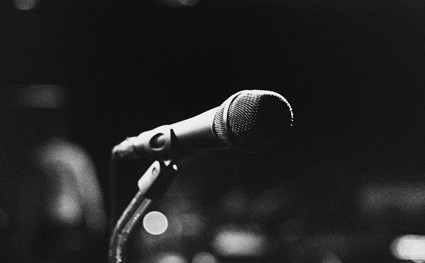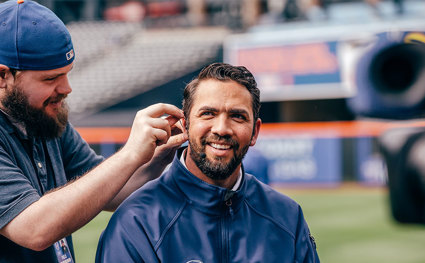How to mic the voice - technology and characteristics
Guidelines for voice miking.

When using microphones it is important to know some of the parameters characterizing the source you are recording, its surroundings and the characteristics of the tools you use to record it.
Voice is probably the most recognizable sound source of all and we can easily detect whether it sounds authentic or not. It will certainly need a good microphone and playback chain to sound similar to what we hear. Not only is the recognizable quality a concern, but other special phenomena occur around the human voice that calls for special attention when selecting the right microphone for the job.
Apart from the microphone’s tonal character and finding the right acoustic surrounding to fit the voice and style, the two most important concerns are:
- The human voice can easily produce SPLs above 135 dB peak in the direct sound field. Vocal microphones on stage are normally used within 10 cm, which will challenge the microphone’s ability to handle sound peaks.
- The human voice will create heavy wind turbulence, also referred to as pop noise.
Microphone technology and characteristics
At DPA Microphones, we believe that when working with most professional artists the microphone should introduce as little coloration as possible. This way, the true characteristics and intentions of the performer are heard without the microphone’s fingerprint. The human voice is a pristine instrument that should not be changed by the equipment being used.
A microphone is a device that transforms acoustic energy into an electrical voltage. Sounds pretty simple and easy – but you need to know this piece of equipment and its possibilities and limitations. Here are some of the parameters to know of and choose from:
- Sound color – do you consider the microphone a tool or an instrument? Should the microphone add something to the voice or should it reproduce the sound?
- Transducer principles
- Directional characteristics
- Proximity effect – the bass level will change depending on distance
- Diaphragm materials
- Sensitivity to handling and wind
- Dynamic range, the range between the microphone’s self noise and the SPL where 1% THD occurs. On top of the dynamic range, a particular headroom is obtainable before clipping occurs.
Vocal microphones in practice
Below are a couple of examples of challenges and solutions:
- Isolation from other sound sources is usually desired but sometimes not an instant solution. In a typical stage setting, an artist will select a standard directional microphone, which are pressure-gradient types that utilize a softer diaphragm. While soft diaphragms are more compliant, they can cause unwanted components that do not derive from the voice, like pop and wind noises. To solve this problem, most stage microphones are used with windscreens and pop filtering. In this situation, users should be aware of the change in behavior of the microphone’s high frequency response and directional characteristics. In many cases, shock absorption is also necessary due to the high dispersion rate of the softer diaphragm material.
- In order to obtain higher output (or create a more intimate performance) singers often have their lips on the grid of the microphone head. Unfortunately, having the mouth to close to the microphone will result in an annoying acoustic distortion, causing it to sound a bit squeezed. Instead, artists should try speaking with a finger right in front of their lips, which will provide the desired audio result! Alternately, experienced singers perform with a short distance from the microphone – which in turn might influence on the bass level, when it’s a cardioid (pressure gradient) microphone.
Visual appearance – when size matters
Audio design in modern theater requires close microphones on all on-stage talent, but does not allow for visible microphones. When high quality miniature microphones entered pro audio, microphones worn on the head became the solution. These are often miniature microphones mounted on the forehead, like the 4060 Miniature Microphone, or headsets.
The main challenge here is that the placement of the microphone is not in the standard reference location, right in front of the mouth. Headsets placed on the cheek will capture less high frequency from the voice, because the high frequency from the voice is very directional. Therefore, high-quality headsets have a frequency response tailored to this exact position.
Speakers
Common to all auditoriums, churches, classrooms, lecture halls, conference rooms, courtrooms and theaters, is that one or more people address an audience. Sometimes, the speaker is not trained to speak in a clear and well-articulated manner. Moreover, you cannot be certain that the speaker knows how to properly use a microphone. The immediate solution is to gain the signal in order to obtain adequate amplification, which may cause excessive sensitivity to acoustical feedback.
A better resolution to this problem is to use a microphone that is worn by the speaker. A headset microphone used in connection with a wireless system provides a number of advantages. First, the microphone is always close to the sound source. As a result, the microphone will not require as much gain. This is especially advantageous if several microphones are used simultaneously. Furthermore, it provides the benefit for the speaker to move about freely as they are not restricted to standing only at a hardwired microphone in one location. With this solution, teachers and presenters can move freely in front of screens, black/whiteboards and other presentation materials.
Singers
During a typical stage performance, there are of a lot of sounds radiated from musical instruments and monitor speakers which interfere with the sound of the singer’s voice. Traditionally, some background sound is wanted. At the same time, however, the singer's voice should sound as nice as possible. This is why a directional headset mic is an excellent first choice in this situation. Compared to an omnidirectional microphone, the design of the cardioid microphone allows for half as much background noise. Furthermore, the low-frequency sounds from equipment such as loudspeakers and drums will be reduced to 1/10 or less.
How to select the right type – omnidirectional or cardioid headset?
| Choose an omnidirectional | Choose a cardioid |
|---|---|
|
|



